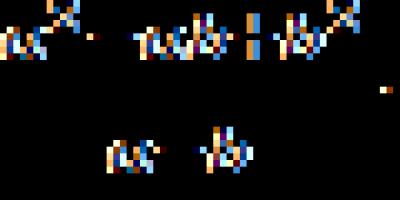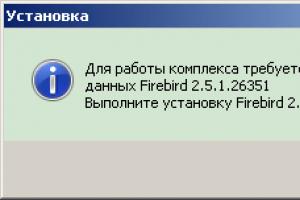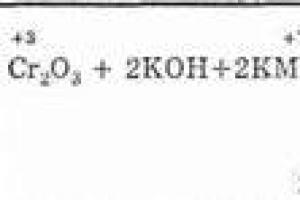In the previous lesson, the concept of a rational expression was already introduced; in today's lesson we continue to work with rational expressions and focus on their transformations. Using specific examples, we will consider methods for solving problems involving transformations of rational expressions and proving the identities associated with them.
Subject:Algebraic fractions. Arithmetic operations on algebraic fractions
Lesson:Converting rational expressions
Let us first recall the definition of a rational expression.
Definition.Rationalexpression- an algebraic expression that does not contain roots and includes only the operations of addition, subtraction, multiplication and division (raising to a power).
By the concept of “transforming a rational expression” we mean, first of all, its simplification. And this is carried out in the order of actions known to us: first the actions in brackets, then product of numbers(exponentiation), dividing numbers, and then adding/subtracting operations.
The main goal of today's lesson will be to gain experience in solving more complex problems of simplifying rational expressions.
Example 1.
Solution. At first it may seem that these fractions can be reduced, since the expressions in the numerators of fractions are very similar to the formulas for the perfect squares of their corresponding denominators. In this case, it is important not to rush, but to separately check whether this is so.
Let's check the numerator of the first fraction: . Now the second numerator: .
As you can see, our expectations were not met, and the expressions in the numerators are not perfect squares, since they do not have doubling of the product. Such expressions, if you recall the 7th grade course, are called incomplete squares. You should be very careful in such cases, because confusing the formula of a complete square with an incomplete one is a very common mistake, and such examples test the student’s attentiveness.
Since reduction is impossible, we will perform the addition of fractions. The denominators do not have common factors, so they are simply multiplied to obtain the lowest common denominator, and the additional factor for each fraction is the denominator of the other fraction.
Of course, you can then open the brackets and then bring similar terms, however, in this case you can get by with less effort and notice that in the numerator the first term is the formula for the sum of cubes, and the second is the difference of cubes. For convenience, let us recall these formulas in general form:
In our case, the expressions in the numerator are collapsed as follows:
, the second expression is similar. We have:
Answer..
Example 2. Simplify rational expression ![]() .
.
Solution. This example is similar to the previous one, but here it is immediately clear that the numerators of the fractions contain partial squares, so reduction at the initial stage of the solution is impossible. Similarly to the previous example, we add the fractions:
Here, similarly to the method indicated above, we noticed and collapsed the expressions using the formulas for the sum and difference of cubes.
Answer..
Example 3. Simplify a rational expression.
Solution. You can notice that the denominator of the second fraction is factorized using the sum of cubes formula. As we already know, factoring denominators is useful for further finding the lowest common denominator of fractions.
Let us indicate the lowest common denominator of the fractions, it is equal to: , since it is divided by the denominator of the third fraction, and the first expression is generally an integer, and any denominator is suitable for it. Having indicated the obvious additional factors, we write:
Answer.
Let's consider a more complex example with “multi-story” fractions.
Example 4. Prove the identity for all admissible values of the variable.
Proof. To prove this identity, we will try to simplify its left side (complex) to the simple form that is required of us. To do this, we will perform all the operations with fractions in the numerator and denominator, and then divide the fractions and simplify the result.
Proven for all permissible values of the variable.
Proven.
In the next lesson we will look in detail at more complex examples of converting rational expressions.
Bibliography
1. Bashmakov M.I. Algebra 8th grade. - M.: Education, 2004.
2. Dorofeev G.V., Suvorova S.B., Bunimovich E.A. and others. Algebra 8. - 5th ed. - M.: Education, 2010.
3. Nikolsky S.M., Potapov M.A., Reshetnikov N.N., Shevkin A.V. Algebra 8th grade. Textbook for general education institutions. - M.: Education, 2006.
2. Lesson developments, presentations, lesson notes ().
Homework
1. No. 96-101. Dorofeev G.V., Suvorova S.B., Bunimovich E.A. and others. Algebra 8. - 5th ed. - M.: Education, 2010.
2. Simplify the expression ![]() .
.
3. Simplify the expression.
4. Prove the identity.
Finished works
DEGREE WORKS
Much has already passed and now you are a graduate, if, of course, you write your thesis on time. But life is such a thing that only now it becomes clear to you that, having ceased to be a student, you will lose all the student joys, many of which you have never tried, putting everything off and putting it off until later. And now, instead of catching up, you're working on your thesis? There is an excellent solution: download the thesis you need from our website - and you will instantly have a lot of free time!
Theses have been successfully defended at leading universities of the Republic of Kazakhstan.
Cost of work from 20,000 tenge
COURSE WORKS
The course project is the first serious practical work. It is with the writing of coursework that preparation for the development of diploma projects begins. If a student learns to correctly present the content of a topic in a course project and format it competently, then in the future he will not have any problems with writing reports, or composing theses, or performing other practical tasks. In order to assist students in writing this type of student work and to clarify questions that arise during its preparation, in fact, this information section was created.
Cost of work from 2,500 tenge
MASTER'S DISSERTATIONS
Currently, in higher educational institutions of Kazakhstan and the CIS countries, the level of higher professional education that follows after bachelor's degree is very common - master's degree. In the master's program, students study with the aim of obtaining a master's degree, which is recognized in most countries of the world more than a bachelor's degree, and is also recognized by foreign employers. The result of master's studies is the defense of a master's thesis.
We will provide you with up-to-date analytical and textual material; the price includes 2 scientific articles and an abstract.
Cost of work from 35,000 tenge
PRACTICE REPORTS
After completing any type of student internship (educational, industrial, pre-graduation), a report is required. This document will be confirmation of the student’s practical work and the basis for forming an assessment for practice. Usually, in order to draw up a report on an internship, you need to collect and analyze information about the enterprise, consider the structure and work routine of the organization in which the internship is taking place, draw up a calendar plan and describe your practical activities.
We will help you write a report on your internship, taking into account the specifics of the activities of a particular enterprise.
Lesson and presentation on the topic: "Transformation of rational expressions. Examples of problem solving"
Additional materials
Dear users, do not forget to leave your comments, reviews, wishes. All materials have been checked by an anti-virus program.
Educational aids and simulators in the Integral online store for grade 8
Manual for the textbook Muravin G.K. A manual for the textbook by Makarychev Yu.N.
The concept of rational expression
The concept of "rational expression" is similar to the concept of "rational fraction". The expression is also represented as a fraction. Only our numerators are not numbers, but various kinds of expressions. Most often these are polynomials. An algebraic fraction is a fractional expression consisting of numbers and variables.When solving many problems in the elementary grades, after performing arithmetic operations, we received specific numerical values, most often fractions. Now after performing the operations we will obtain algebraic fractions. Guys, remember: to get the correct answer, you need to simplify the expression you are working with as much as possible. One must obtain the smallest degree possible; identical expressions in numerators and denominators should be reduced; with expressions that can be collapsed, you must do so. That is, after performing a series of actions, we should obtain the simplest possible algebraic fraction.
Procedure with rational expressions
The procedure for performing operations with rational expressions is the same as for arithmetic operations. First, the operations in parentheses are performed, then multiplication and division, exponentiation, and finally addition and subtraction.To prove an identity means to show that for all values of the variables the right and left sides are equal. There are a lot of examples of proving identities.
The main ways to solve identities include.
- Transform the left side to be equal to the right side.
- Transform the right side to be equal to the left.
- Transform the left and right sides separately until you get the same expression.
- The right side is subtracted from the left side, and the result should be zero.
Converting rational expressions. Examples of problem solving
Example 1.Prove the identity:
$(\frac(a+5)(5a-1)+\frac(a+5)(a+1)):(\frac(a^2+5a)(1-5a))+\frac(a ^2+5)(a+1)=a-1$.
Solution.
Obviously, we need to transform the left side.
First, let's do the steps in parentheses:
1) $\frac(a+5)(5a-1)+\frac(a+5)(a+1)=\frac((a+5)(a+1)+(a+5)(5a -1))((a+1)(5a-1))=$
$=\frac((a+5)(a+1+5a-1))((a+1)(5a-1))=\frac((a+5)(6a))((a+1 )(5a-1))$
You should try to apply common factors to the maximum.
2) Transform the expression by which we divide:
$\frac(a^2+5a)(1-5a)=\frac(a(a+5))((1-5a)=\frac(a(a+5))(-(5a-1) )$
.3) Perform the division operation:
$\frac((a+5)(6a))((a+1)(5a-1)):\frac(a(a+5))(-(5a-1))=\frac((a +5)(6a))((a+1)(5a-1))*\frac(-(5a-1))(a(a+5))=\frac(-6)(a+1) $.
4) Perform the addition operation:
$\frac(-6)(a+1)+\frac(a^2+5)(a+1)=\frac(a^2-1)(a+1)=\frac((a-1 )(a+1))(a+))=a-1$.
The right and left parts coincided. This means the identity is proven.
Guys, when solving this example we needed knowledge of many formulas and operations. We see that after the transformation, the large expression has turned into a very small one. When solving almost all problems, transformations usually lead to simple expressions.
Example 2.
Simplify the expression:
$(\frac(a^2)(a+b)-\frac(a^3)(a^2+2ab+b^2)):(\frac(a)(a+b)-\frac( a^2)(a^2-b^2))$.
Solution.
Let's start with the first brackets.
1. $\frac(a^2)(a+b)-\frac(a^3)(a^2+2ab+b^2)=\frac(a^2)(a+b)-\frac (a^3)((a+b)^2)=\frac(a^2(a+b)-a^3)((a+b)^2)=$
$=\frac(a^3+a^2 b-a^3)((a+b)^2)=\frac(a^2b)((a+b)^2)$.
2. Transform the second brackets.
$\frac(a)(a+b)-\frac(a^2)(a^2-b^2)=\frac(a)(a+b)-\frac(a^2)((a-b )(a+b))=\frac(a(a-b)-a^2)((a-b)(a+b))=$
$=\frac(a^2-ab-a^2)((a-b)(a+b))=\frac(-ab)((a-b)(a+b))$.
3. Let's do the division.
$\frac(a^2b)((a+b)^2):\frac(-ab)((a-b)(a+b))=\frac(a^2b)((a+b)^2 )*\frac((a-b)(a+b))((-ab))=$
$=-\frac(a(a-b))(a+b)$
Answer: $-\frac(a(a-b))(a+b)$.
Example 3.
Follow these steps:
$\frac(k-4)(k-2):(\frac(80k)((k^3-8)+\frac(2k)(k^2+2k+4)-\frac(k-16 )(2-k))-\frac(6k+4)((4-k)^2)$.
Solution.
As always, you need to start with the brackets.
1. $\frac(80k)(k^3-8)+\frac(2k)(k^2+2k+4)-\frac(k-16)(2-k)=\frac(80k)( (k-2)(k^2+2k+4)) +\frac(2k)(k^2+2k+4)+\frac(k-16)(k-2)=$
$=\frac(80k+2k(k-2)+(k-16)(k^2+2k+4))((k-2)(k^2+2k+4))=\frac(80k +2k^2-4k+k^3+2k^2+4k-16k^2-32k-64)((k-2)(k^2+2k+4))=$
$=\frac(k^3-12k^2+48k-64)((k-2)(k^2+2k+4))=\frac((k-4)^3)((k-2 )(k^2+2k+4))$.
2. Now let's do the division.
$\frac(k-4)(k-2):\frac((k-4)^3)((k-2)(k^2+2k+4))=\frac(k-4)( k-2)*\frac((k-2)(k^2+2k+4))((k-4)^3)=\frac((k^2+2k+4))((k- 4)^2)$.
3. Let's use the property: $(4-k)^2=(k-4)^2$.
4. Let's perform the subtraction operation.
$\frac((k^2+2k+4))((k-4)^2)-\frac(6k+4)((k-4)^2)=\frac(k^2-4k) ((k-4)^2)=\frac(k(k-4))((k-4)^2)=\frac(k)(k-4)$.
As we said earlier, you need to simplify the fraction as much as possible.
Answer: $\frac(k)(k-4)$.
Problems to solve independently
1. Prove the identity:$\frac(b^2-14)(b-4)-(\frac(3-b)(7b-4)+\frac(b-3)(b-4))*\frac(4-7b )(9b-3b^2)=b+4$.
2. Simplify the expression:
$\frac(4(z+4)^2)(z-2)*(\frac(z)(2z-4)-\frac(z^2+4)(2z^2-8)-\frac (2)(z^2+2z))$.
3. Follow these steps:
$(\frac(a-b)(a^2+2ab+b^2)-\frac(2a)((a-b)(a+b))+\frac(a-b)((a-b)^2))*\ frac(a^4-b^4)(8ab^2)+\frac(2b^2)(a^2-b^2)$.
Rational expressions and fractions are the cornerstone of the entire algebra course. Those who learn to work with such expressions, simplify them and factor them, will essentially be able to solve any problem, since transforming expressions is an integral part of any serious equation, inequality, or even word problem.
In this video tutorial we will look at how to correctly use abbreviated multiplication formulas to simplify rational expressions and fractions. Let's learn to see these formulas where, at first glance, there is nothing. At the same time, we will repeat such a simple technique as factoring a quadratic trinomial through a discriminant.
As you probably already guessed from the formulas behind me, today we will study abbreviated multiplication formulas, or, more precisely, not the formulas themselves, but their use to simplify and reduce complex rational expressions. But, before moving on to solving examples, let's take a closer look at these formulas or remember them:
- $((a)^(2))-((b)^(2))=\left(a-b \right)\left(a+b \right)$ — difference of squares;
- $((\left(a+b \right))^(2))=((a)^(2))+2ab+((b)^(2))$ is the square of the sum;
- $((\left(a-b \right))^(2))=((a)^(2))-2ab+((b)^(2))$ — squared difference;
- $((a)^(3))+((b)^(3))=\left(a+b \right)\left(((a)^(2))-ab+((b)^( 2)) \right)$ is the sum of cubes;
- $((a)^(3))-((b)^(3))=\left(a-b \right)\left(((a)^(2))+ab+((b)^(2) ) \right)$ is the difference of cubes.
I would also like to note that our school education system is structured in such a way that it is with the study of this topic, i.e. rational expressions, as well as roots, modules, all students have the same problem, which I will now explain.
The fact is that at the very beginning of studying abbreviated multiplication formulas and, accordingly, actions to reduce fractions (this is somewhere in the 8th grade), teachers say something like the following: “If something is not clear to you, then don’t worry, we will help you.” We will return to this topic more than once, in high school for sure. We'll look into this later." Well, then, at the turn of 9-10 grades, the same teachers explain to the same students who still don’t know how to solve rational fractions, something like this: “Where were you the previous two years? This was studied in algebra in 8th grade! What could be unclear here? It’s so obvious!”
However, such explanations do not make it any easier for ordinary students: they still had a mess in their heads, so right now we will look at two simple examples, on the basis of which we will see how to isolate these expressions in real problems, which will lead us to abbreviated multiplication formulas and how to then apply this to transform complex rational expressions.
Reducing simple rational fractions
Task No. 1
\[\frac(4x+3((y)^(2)))(9((y)^(4))-16((x)^(2)))\]
The first thing we need to learn is to identify exact squares and higher powers in the original expressions, on the basis of which we can then apply formulas. Let's get a look:
Let's rewrite our expression taking into account these facts:
\[\frac(4x+3((y)^(2)))(((\left(3((y)^(2)) \right))^(2))-((\left(4x \right))^(2)))=\frac(4x+3((y)^(2)))(\left(3((y)^(2))-4x \right)\left(3 ((y)^(2))+4x \right))=\frac(1)(3((y)^(2))-4x)\]
Answer: $\frac(1)(3((y)^(2))-4x)$.
Problem No. 2
Let's move on to the second task:
\[\frac(8)(((x)^(2))+5xy-6((y)^(2)))\]
There is nothing to simplify here, because the numerator contains a constant, but I proposed this problem precisely so that you learn how to factor polynomials containing two variables. If instead we had the polynomial below, how would we expand it?
\[((x)^(2))+5x-6=\left(x-... \right)\left(x-... \right)\]
Let's solve the equation and find the $x$ that we can put in place of the dots:
\[((x)^(2))+5x-6=0\]
\[((x)_(1))=\frac(-5+7)(2)=\frac(2)(2)=1\]
\[((x)_(2))=\frac(-5-7)(2)=\frac(-12)(2)=-6\]
We can rewrite the trinomial as follows:
\[((x)^(2))+5xy-6((y)^(2))=\left(x-1 \right)\left(x+6 \right)\]
We learned how to work with a quadratic trinomial - that's why we needed to record this video lesson. But what if, in addition to $x$ and a constant, there is also $y$? Let's consider them as another element of the coefficients, i.e. Let's rewrite our expression as follows:
\[((x)^(2))+5y\cdot x-6((y)^(2))\]
\[((x)_(1))=\frac(-5y+7y)(2)=y\]
\[((x)_(2))=\frac(-5y-7y)(2)=\frac(-12y)(2)=-6y\]
Let us write the expansion of our square construction:
\[\left(x-y \right)\left(x+6y \right)\]
So, if we return to the original expression and rewrite it taking into account the changes, we get the following:
\[\frac(8)(\left(x-y \right)\left(x+6y \right))\]
What does such a record give us? Nothing, because it cannot be reduced, it is not multiplied or divided by anything. However, as soon as this fraction turns out to be an integral part of a more complex expression, such an expansion will come in handy. Therefore, as soon as you see a quadratic trinomial (it does not matter whether it is burdened with additional parameters or not), always try to factor it.
Nuances of the solution
Remember the basic rules for converting rational expressions:
- All denominators and numerators must be factored either through abbreviated multiplication formulas or through a discriminant.
- You need to work according to the following algorithm: when we look and try to isolate the formula for abbreviated multiplication, then, first of all, we try to convert everything to the highest possible degree. After this, we take the overall degree out of the bracket.
- Very often you will encounter expressions with a parameter: other variables will appear as coefficients. We find them using the quadratic expansion formula.
So, once you see rational fractions, the first thing to do is factor both the numerator and denominator into linear expressions, using the abbreviated multiplication or discriminant formulas.
Let's look at a couple of these rational expressions and try to factor them.
Solving more complex examples
Task No. 1
\[\frac(4((x)^(2))-6xy+9((y)^(2)))(2x-3y)\cdot \frac(9((y)^(2))- 4((x)^(2)))(8((x)^(3))+27((y)^(3)))\]
We rewrite and try to decompose each term:
Let's rewrite our entire rational expression taking into account these facts:
\[\frac(((\left(2x \right))^(2))-2x\cdot 3y+((\left(3y \right))^(2)))(2x-3y)\cdot \frac (((\left(3y \right))^(2))-((\left(2x \right))^(2)))(((\left(2x \right))^(3))+ ((\left(3y \right))^(3)))=\]
\[=\frac(((\left(2x \right))^(2))-2x\cdot 3y+((\left(3y \right))^(2)))(2x-3y)\cdot \ frac(\left(3y-2x \right)\left(3y+2x \right))(\left(2x+3y \right)\left(((\left(2x \right))^(2))- 2x\cdot 3y+((\left(3y \right))^(2)) \right))=-1\]
Answer: $-1$.
Problem No. 2
\[\frac(3-6x)(2((x)^(2))+4x+8)\cdot \frac(2x+1)(((x)^(2))+4-4x)\ cdot \frac(8-((x)^(3)))(4((x)^(2))-1)\]
Let's look at all the fractions.
\[((x)^(2))+4-4x=((x)^(2))-4x+2=((x)^(2))-2\cdot 2x+((2)^( 2))=((\left(x-2 \right))^(2))\]
Let's rewrite the entire structure taking into account the changes:
\[\frac(3\left(1-2x \right))(2\left(((x)^(2))+2x+((2)^(2)) \right))\cdot \frac( 2x+1)(((\left(x-2 \right))^(2)))\cdot \frac(\left(2-x \right)\left(((2)^(2))+ 2x+((x)^(2)) \right))(\left(2x-1 \right)\left(2x+1 \right))=\]
\[=\frac(3\cdot \left(-1 \right))(2\cdot \left(x-2 \right)\cdot \left(-1 \right))=\frac(3)(2 \left(x-2 \right))\]
Answer: $\frac(3)(2\left(x-2 \right))$.
Nuances of the solution
So what we just learned:
- Not every square trinomial can be factorized; in particular, this applies to the incomplete square of the sum or difference, which are very often found as parts of sum or difference cubes.
- Constants, i.e. ordinary numbers that do not have variables can also act as active elements in the expansion process. Firstly, they can be taken out of brackets, and secondly, the constants themselves can be represented in the form of powers.
- Very often, after factoring all the elements, opposite constructions arise. These fractions must be reduced extremely carefully, because when crossing them out either above or below, an additional factor $-1$ appears - this is precisely a consequence of the fact that they are opposites.
Solving complex problems
\[\frac(27((a)^(3))-64((b)^(3)))(((b)^(2))-4):\frac(9((a)^ (2))+12ab+16((b)^(2)))(((b)^(2))+4b+4)\]
Let's consider each term separately.
First fraction:
\[((\left(3a \right))^(3))-((\left(4b \right))^(3))=\left(3a-4b \right)\left(((\left (3a \right))^(2))+3a\cdot 4b+((\left(4b \right))^(2)) \right)\]
\[((b)^(2))-((2)^(2))=\left(b-2 \right)\left(b+2 \right)\]
We can rewrite the entire numerator of the second fraction as follows:
\[((\left(3a \right))^(2))+3a\cdot 4b+((\left(4b \right))^(2))\]
Now let's look at the denominator:
\[((b)^(2))+4b+4=((b)^(2))+2\cdot 2b+((2)^(2))=((\left(b+2 \right ))^(2))\]
Let's rewrite the entire rational expression taking into account the above facts:
\[\frac(\left(3a-4b \right)\left(((\left(3a \right))^(2))+3a\cdot 4b+((\left(4b \right))^(2 )) \right))(\left(b-2 \right)\left(b+2 \right))\cdot \frac(((\left(b+2 \right))^(2)))( ((\left(3a \right))^(2))+3a\cdot 4b+((\left(4b \right))^(2)))=\]
\[=\frac(\left(3a-4b \right)\left(b+2 \right))(\left(b-2 \right))\]
Answer: $\frac(\left(3a-4b \right)\left(b+2 \right))(\left(b-2 \right))$.
Nuances of the solution
As we have seen once again, incomplete squares of the sum or incomplete squares of the difference, which are often found in real rational expressions, however, do not be afraid of them, because after transforming each element they are almost always canceled. In addition, in no case should you be afraid of large constructions in the final answer - it is quite possible that this is not your mistake (especially if everything is factorized), but the author intended such an answer.
In conclusion, I would like to look at another complex example, which no longer directly relates to rational fractions, but it contains everything that awaits you on real tests and exams, namely: factorization, reduction to a common denominator, reduction of similar terms. This is exactly what we will do now.
Solving a complex problem of simplifying and transforming rational expressions
\[\left(\frac(x)(((x)^(2))+2x+4)+\frac(((x)^(2))+8)(((x)^(3) )-8)-\frac(1)(x-2) \right)\cdot \left(\frac(((x)^(2)))(((x)^(2))-4)- \frac(2)(2-x) \right)\]
First, let's look at and open the first bracket: in it we see three separate fractions with different denominators, so the first thing we need to do is bring all three fractions to a common denominator, and to do this, each of them should be factored:
\[((x)^(2))+2x+4=((x)^(2))+2\cdot x+((2)^(2))\]
\[((x)^(2))-8=((x)^(3))-((2)^(2))=\left(x-2 \right)\left(((x) ^(2))+2x+((2)^(2)) \right)\]
Let's rewrite our entire construction as follows:
\[\frac(x)(((x)^(2))+2x+((2)^(2)))+\frac(((x)^(2))+8)(\left(x -2 \right)\left(((x)^(2))+2x+((2)^(2)) \right))-\frac(1)(x-2)=\]
\[=\frac(x\left(x-2 \right)+((x)^(3))+8-\left(((x)^(2))+2x+((2)^(2 )) \right))(\left(x-2 \right)\left(((x)^(2))+2x+((2)^(2)) \right))=\]
\[=\frac(((x)^(2))-2x+((x)^(2))+8-((x)^(2))-2x-4)(\left(x-2 \right)\left(((x)^(2))+2x+((2)^(2)) \right))=\frac(((x)^(2))-4x-4)(\ left(x-2 \right)\left(((x)^(2))+2x+((2)^(2)) \right))=\]
\[=\frac(((\left(x-2 \right))^(2)))(\left(x-2 \right)\left(((x)^(2))+2x+(( 2)^(2)) \right))=\frac(x-2)(((x)^(2))+2x+4)\]
This is the result of the calculations from the first bracket.
Let's deal with the second bracket:
\[((x)^(2))-4=((x)^(2))-((2)^(2))=\left(x-2 \right)\left(x+2 \ right)\]
Let's rewrite the second bracket taking into account the changes:
\[\frac(((x)^(2)))(\left(x-2 \right)\left(x+2 \right))+\frac(2)(x-2)=\frac( ((x)^(2))+2\left(x+2 \right))(\left(x-2 \right)\left(x+2 \right))=\frac(((x)^ (2))+2x+4)(\left(x-2 \right)\left(x+2 \right))\]
Now let's write down the entire original construction:
\[\frac(x-2)(((x)^(2))+2x+4)\cdot \frac(((x)^(2))+2x+4)(\left(x-2 \right)\left(x+2 \right))=\frac(1)(x+2)\]
Answer: $\frac(1)(x+2)$.
Nuances of the solution
As you can see, the answer turned out to be quite reasonable. However, please note: very often during such large-scale calculations, when the only variable appears only in the denominator, students forget that this is the denominator and it should be at the bottom of the fraction and write this expression in the numerator - this is a gross mistake.
In addition, I would like to draw your special attention to how such tasks are formalized. In any complex calculations, all steps are performed one by one: first we count the first bracket separately, then the second one separately, and only at the end do we combine all the parts and calculate the result. In this way, we insure ourselves against stupid mistakes, carefully write down all the calculations and at the same time do not waste any extra time, as it might seem at first glance.








